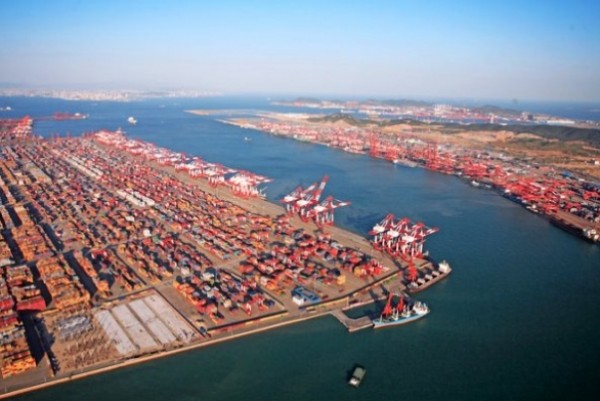| China Has Strategy To Capture Supply Chains From Guangzhou To Greece | |

| Author: Dane Chamorro, Forbes |
| 26th December 2017 |
| ANALYSIS - On his recent Asian tour, President Donald Trump made headlines with his use of the phrase “a free and open Indo-Pacific”. Coming several weeks after China enshrined “Xi Jinping Thought” in the national constitution and the Belt and Road Initiative (BRI or literally One Belt One Road) was confirmed at the 19th National Congress of the Communist Party of China, this turn of phrase was in part a response to Beijing’s attempts to capitalize on its growing economic dominance in Asia and beyond. |
|
China’s overseas investment has been growing steadily for many years, but it took Xi’s political deftness to encapsulate a somewhat halting, fragmented effort into a coherent, strategic (and partly aspirational) framework worth up to 1 trillion USD. When combined with China’s growing military projection capabilities and financing entities, it is a powerful vision around which China’s foreign policy will be executed for the foreseeable future. The BRI is designed to strengthen Beijing’s role in the world economically and strategically, to satisfy China’s excess construction and industrial capacity and to provide an outlet for Chinese products to a growing class of emerging-market buyers. The geopolitical ramifications are not lost on Moscow, Tokyo, Delhi or Washington DC. As long-time China observer David Ignatius recently wrote, “China is building the infrastructure of power”. Arguably the most serious challenge to the geo-strategic status quo lies in China’s program to dominate the maritime logistics network from East Asia and across the Indian Ocean to South-Eastern Europe, including ports and warehousing assets. In part, this strategy aims to secure China’s energy supplies – namely, the sea “lines of communication”. But it is also logical that China would seek to leverage its role, as its commercial and trade interests have grown, by facilitating and financing the infrastructure that allows both to flourish, just as just as London financed ports, railroads and telegraph networks in the 19th century. Simultaneously, this on-the-ground presence enables Beijing to promote its national and corporate interests. In the last three years China has planned, developed or acquired controlling interests in major ports in Malaysia, Brunei, Myanmar, Sri Lanka, Pakistan, Kenya, Djibouti, Turkey and Greece. China now has direct stakes in the ports that clear approximately two-thirds of the world’s container volume – aided by its role as a top sea freight handler through China COSCO Shipping (which purchased Hong Kong’s OOCL line in July). The country is also snapping up warehousing and logistics operators. China has taken 19th century US strategic theorist Alfred Thayer Mahan’s concept of “control of the seas” to heart and made it policy. Nowhere is China’s maritime and economic influence more keenly felt than in South-East Asia, where bilateral trade has increased tenfold since 2000 to around $400 billion (China’s trade with the countries of ASEAN now almost equals its trade with all of the other BRI countries combined). In addition to ports and trade, China has proffered direct investment into industrial zones, refineries, and high-speed rail (HSR), pipeline, power and telecom networks in almost tit-for-tat competition with Japan. In fact, despite headlines about rail and pipelines crossing Central Asia, South-East Asia is the BRI’s largest beneficiary to date. Even in South-East Asia, where China is a familiar (if not always welcome) actor and the largest trading partner, fulfillment of the BRI will not be easy. Infrastructure projects are notoriously difficult everywhere, but in emerging markets they assume an unrivaled complexity, hampered by the hosts’ structural weaknesses. China will face many of the same challenges that confront other direct investors – for example, continuity of policy, institutional capacity, and land acquisition – current delays to the Jakarta-Bandung HSR project being but one example. However, Beijing is playing the long game. Its financing model helps overcome many of these challenges since its banks lend on a strategic, long-term basis with central government direction rather than standard commercial terms. For instance, the China Development Bank and the Export-Import Bank of China routinely lend several times what the Asian Development Bank does on an annual basis. Some of this capital will surely be lost in “white elephant” projects but in general it is positive, as the world’s financial equilibrium requires that China’s dollar surpluses recycle. Beijing has cleverly chosen to achieve this (partially) through a global strategic infrastructure initiative, the primary goal of which is to benefit China. Some of the BRI’s aims is aspirational and may never be fulfilled. But where the investment program is well managed by the recipients, it will also bring permanent – in some cases truly transformational – benefits to the participating countries. It will also undoubtedly increase China’s power and prestige at the expense of established state (and corporate) actors. If the 19th century belonged to Europe, and the 20th to America, the 21st is without question the century of the “Indo-Pacific”. Since China has chosen to provide the vision, leadership, capital and expertise for the development and modernization of the region’s infrastructure, it shouldn’t be surprising that it is already emerging as the dominant regional power. Dane Chamorro is a Senior Partner and the head of ASEAN operations at Control Risks, the global specialist risk consultancy.
|
 |
|
| 23rd November 2024 | |
| China has good news for Croatian citizens | |
 |
|
| 7th November 2024 | |
| Pelagos net farm products presented at the Shanghai fai | |